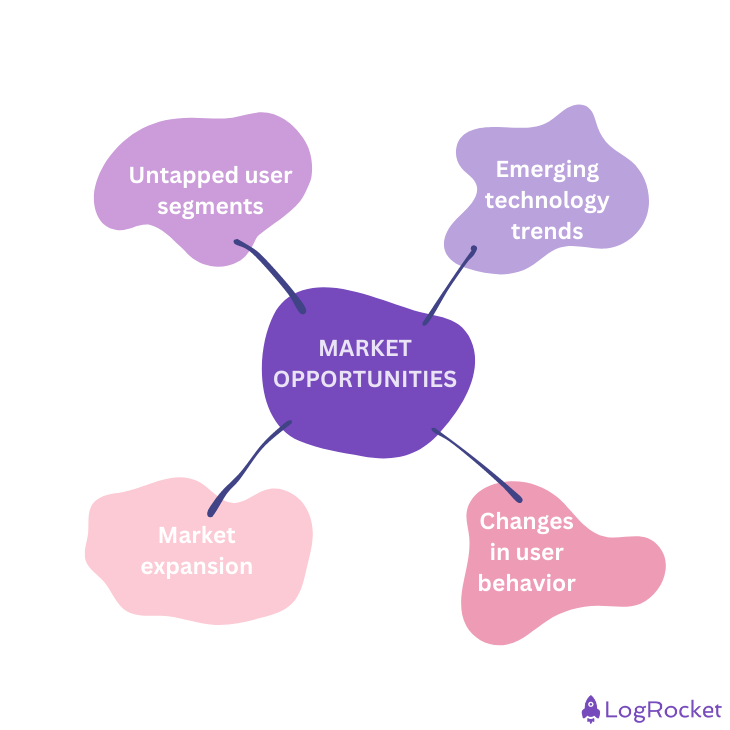Market opportunity analysis is the pivotal first step in crafting both a company’s initial strategy and its product strategy.

Product managers bear the responsibility of identifying and assessing market opportunities. A comprehensive market opportunity analysis serves as the compass that directs all strategic product decisions, allowing product managers to align their product initiatives with market demands and user needs.
Thoroughly analyzing the target market — including its size, growth potential, trends, and user preferences — enables product managers to strategically position their products, optimize pricing strategies, refine marketing efforts alongside product marketing managers, and uncover overlooked segments and issues ripe for growth.
Market opportunities refer to favorable circumstances or conditions within a specific industry that present businesses with the potential for success, profit generation, and competitive advantage. These opportunities arise from various factors and are identified through rigorous market analysis and research.
The process of identifying market opportunities involves evaluating the dynamics of the market and pinpointing areas of deficiency or unmet demand (also known as user problems). Through careful examination of market data and diligent research, product teams can reveal potential opportunities that align with their core product strategy. These opportunities can then be monetized directly or indirectly by the business:

Market opportunities may manifest in several forms, including:
This could involve identifying a group of users or entire niches typically overlooked by your competitors. For instance, a social media platform might identify a growing segment of elderly users with unique needs and develop a dedicated set of features to cater to these requirements.
This could entail monitoring the market for technological trends capable of disrupting it, then leveraging these trends to enhance your company’s competitive edge.
A prime example is the emerging trend of AI technologies like ChatGPT. Companies have harnessed generative AI capabilities to create various features addressing multiple user problems.
Market expansion could involve spotting opportunities to penetrate new geographical locations or target entirely different user demographics.
User preferences, problems, and values evolve over time. Recognizing this presents an opportunity for companies and product teams to remain sustainable by retaining their target users while attracting new ones.
An example would be the global trend toward reducing plastic bag usage and cardboard packaging in shopping. For an e-commerce platform, this might mean adding an option for users to choose whether they want a plastic bag or prefer eco-friendly alternatives.
Market opportunity analysis is a strategic process employed by product managers to assess and evaluate potential opportunities in the market. This strategic framework aids product managers in analyzing the potential success of various opportunities, thereby informing decisions about the overarching product strategy.
The ideal outcome of an effective market opportunity analysis is a clear direction on whether to pursue (invest in), pause (wait on), or skip (kill) an opportunity.
Analyzing market opportunities is a crucial step in crafting a robust product strategy. It equips the product team with vital insights needed to make data-driven decisions about the direction of the product strategy. Here are some top benefits of conducting a market opportunity analysis for your product strategy:
Market opportunity analysis differs from the typical research activities product managers engage in daily, such as user research. It’s usually undertaken by the head of product or the VP of product to identify and explore significant opportunities.
Here are the 10 steps involved in conducting a market opportunity analysis:
The first step is for the product manager to clearly define the objective behind the market opportunity analysis initiative. This could be identifying new target markets or users, reassessing user needs, or exploring product diversification.
Next, plan and specify which market and user segment they will focus their research on. Factors such as demographics, geographic location, industry verticals, user personas, and products used should be considered.
Collect all relevant data about the existing market and user personas, as well as those you plan to target. This includes data points like total addressable market size, growth rate, trends, user preferences, competitive landscape, and regulatory and environmental factors. Both primary and secondary research methods should be utilized at this stage.
The next step involves conducting a competitive analysis to understand competitors’ strengths, weaknesses, and strategies within your target market. The aim here is to identify gaps where your product can differentiate itself and offer unique value. A lot of brainstorming and ideation sessions will take place at this stage with the goal of formulating a clear value proposition for the strategic direction being pursued.
Techniques like surveys, interviews, focus groups, contextual inquiry, and diary studies can be used to gather insights into user needs, pain points, preferences. Understanding their behavior patterns helps align the product strategy with user expectations.
Once all data has been collected from previous steps, it’s time for synthesis sessions. Work with your team to identify gaps in the market or unmet user needs that your product could potentially address. You should mainly look for areas where problems aren’t adequately solved or where competitors are underserving certain segments.
You should also conduct minor research into technological trends so that you’re fully updated on advancements that may impact your target market. Assess how these emerging technologies can create new opportunities or disrupt planned markets. Then, reflect on these findings with your team to see how they can utilize these trends when building better products.
Working closely with management teams allows you to evaluate potential growth opportunities in terms of profitability and sustainability within a given marketplace. Strategic frameworks such as Porter’s Five Forces are often used at this stage for thorough viability assessment before deciding whether an opportunity is worth investing in.
Assuming that you’ve decided to invest in an opportunity, it’s time to develop or update your product strategy accordingly. This outlines next steps for teams, including what features need developing, along with respective roadmaps.
Last but not least, remember that markets are dynamic. Keep monitoring changes based on feedback from users as well as competitor moves. Your team should remain agile enough to change strategies even within short business quarters if necessary.
Market opportunity analysis plays an integral role in a product’s success. It involves identifying target markets, understanding user needs, standing out from competitors, managing risks, and maximizing growth potential.
By conducting thorough analysis and research, product managers can make informed decisions that drive successful product strategies. This helps create products that meet market demand, gain a competitive edge, and achieve sustainable growth.
Featured image source: IconScout
LogRocket identifies friction points in the user experience so you can make informed decisions about product and design changes that must happen to hit your goals.
With LogRocket, you can understand the scope of the issues affecting your product and prioritize the changes that need to be made. LogRocket simplifies workflows by allowing Engineering, Product, UX, and Design teams to work from the same data as you, eliminating any confusion about what needs to be done.
Get your teams on the same page — try LogRocket today.

Chrissie Lamond, VP of Product at Mansueto Ventures, talks about how she builds product experiences across audience segments.

AI governance is now a product feature. Learn how to embed trust, transparency, and compliance into your build cycles.

Rachel Bentley shares the importance of companies remaining transparent about reviews and where they’re sourced from to foster user trust.

Michal Ochnicki talks about the importance of ensuring that the ecommerce side of a business is complementary to the whole organization.
One Reply to "How to identify and analyze market opportunities"
Very well and simply written. 👍